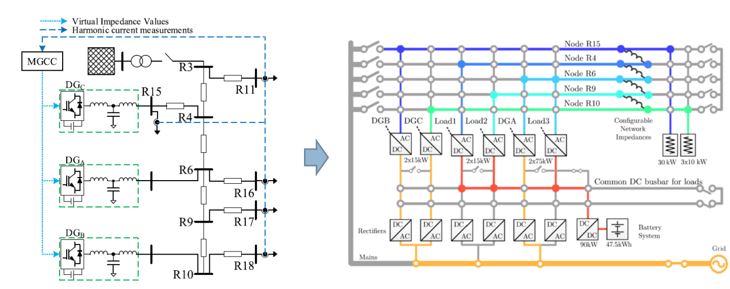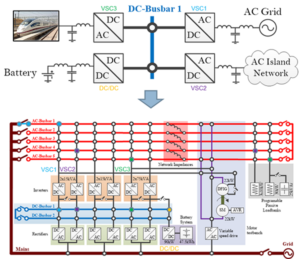Technological Offer
Real time emulation of electrical power networks, development and testing of control algorithms in energy systems

Description
IMDEA Energy has created a test environment specifically designed for research, development and testing of control algorithms in energy systems. This Power-Hardware-In-the-Loop environment called “Smart Energy Integration Lab” is designed for accelerating the process of control design development necessary for integrating energy resources to electricity networks. This platform allows analysis, development and testing of realistic scenarios for AC and DC network integration and operation of distribution power networks, islanded networks and microgrids.

Figure 1: Design of harmonic impedances for optimal management of power quality in microgrids (in collaboration with NTNU and SINTEF)[1]
Renewable energy integration to electrical power networks is the key to make decarbonisation of energy system. The process of integration assumes the development of new control and management algorithms for renewable sources and grid operators. However, as testing of power networks is not possible, IMDEA Energy has created a test environment specifically designed for research, development and testing of control algorithms in energy systems. This environment, or testing laboratory, accelerates the process of control design development necessary for connecting energy resources to electricity networks. The approximate lab capacity for power processing is 210kVA and it is formed by a set of power electronics converters, resistive load-banks, 47.5kWh battery system, AC and DC distribution panels, coupled motor testbench and monitoring and control systems. This platform allows analysis, development, and testing of realistic scenarios for energy integration in both AC and DC networks and operation of distribution power networks, islanded networks and microgrids. The results obtained from this test environment are more reliable and accurate than any model-based computer simulation.
Control and communication infrastructure in SEIL
What distinguishes this laboratory is its flexibility in the implementation of control algorithms and implementation of energy management algorithms. For example, the lab network is capable of emulating at the same time a generation and load mix consisting of various wind, photo-voltaic and conventional generators and passive and active loads altogether connected to a wide area network whose dynamic is emulated in real-time. The role for the power converters acting as energy resources in such a network is simply defined by assigning a different control block to each one of them. In addition to this, the battery system installation offers all the flexibility needed for the development of management algorithms for future power network.
Control algorithms for power inverters are programmed via Matlab Simulink and code generation tools and are then executed in real-time on industrial PCs. Real-time data exchange provides Access to all control variables and parameters during the test. In this way, the desired flexibility in reproducing real dynamic characteristics of any energy source, generator or load it is achieved.
The monitoring and control system allow an independent, remote, real-time access to laboratory resources including the network reconfiguration, control of contactors and connection to the external power grid. Moreover, by harnessing the potential of the communication network installations any centralized or decentralized management control algorithm can be achieved.
Advantages and Innovations
- Advanced control algorithms for power electronic interfaces
- Real-time emulation of power network operation
- Real-time proactive algorithms for energy management of microgrids
- Flexible, model-based approach in forming energy systems and their components
- Test environment for integration of conventional generation and renewable and storage technologies
- Facilitates the implementation of energy management scenarios
- Grid-connected or islanded operation
- Easy access to all the configuration, test and control data
- Possibility to test all control and management algorithms in real-time and by using real power conversion
Market Applications
The main market application sectors are:
- Grid integration of renewable technologies, distributed generation, and energy storage
- Energy management for small power systems and buildings
- Stability and power flow analysis for power networks and microgrids
- Development of control algorithms for power electronics interfaces
- Power quality testing improvement
- Power electronics applications FACTS, HVDC, Active filters etc.
- Proof of concept for converter control development including their real-time validation
- Real-time testing of secondary control algorithms for energy systems and microgrids
- Real-time testing of Energy Management Systems (EMS)
- Renewable and battery converter operating under real network events.
- Real-time testing of Virtual Power Plant and Demand management algorithms
Contact
Félix Marín, felix.marin@imdea.org
References
[1] F. Göthner, J. Roldán-Pérez, R. E. Torres-Olguin and O. -M. Midtgård, “Harmonic Virtual Impedance Design for Optimal Management of Power Quality in Microgrids,” in IEEE Transactions on Power Electronics, vol. 36, no. 9, pp. 10114-10126, Sept. 2021, doi: 10.1109/TPEL.2021.3065755.
[2] A. Rodríguez-Cabero, M. Jimenez-Carrizosa, J. Roldán-Pérez, M. Prodanovic. Stability Analysis and Hierarchical Control of DC Microgrids. Modelling, Operation and Analysis of DC Grids. Book chapter, Academic Press (Elsevier). ISBN: 9780128221013
[3] A. Rodríguez-Cabero, J. Roldán-Pérez, M. Prodanovic, J. A. Suul and S. D’Arco, “Coupling of AC Grids via VSC-HVDC Interconnections for Oscillation Damping Based on Differential and Common Power Control,” in IEEE Transactions on Power Electronics, vol. 35, no. 6, pp. 6548-6558, June 2020. DOI: 10.1109/TPEL.2019.2952656

Figure 2: Control and communication infrastructure in SEIL

Figure 3: Railway system substation using DC microgrid and energy storage [2]


